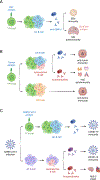T cell help in the autoreactive germinal center
- PMID: 35587582
- PMCID: PMC9250425
- DOI: 10.1111/sji.13192
T cell help in the autoreactive germinal center
Abstract
The germinal center serves as a site of B cell selection and affinity maturation, critical processes for productive adaptive immunity. In autoimmune disease tolerance is broken in the germinal center reaction, leading to production of autoreactive B cells that may propagate disease. Follicular T cells are crucial regulators of this process, providing signals necessary for B cell survival in the germinal center. Here, we review the emerging roles of follicular T cells in the autoreactive germinal center. Recent advances in immunological techniques have allowed study of the gene expression profiles and repertoire of follicular T cells at unprecedented resolution. These studies provide insight into the potential role follicular T cells play in preventing or facilitating germinal center loss of tolerance. Improved understanding of the mechanisms of T cell help in autoreactive germinal centers provides novel therapeutic targets for diseases of germinal center dysfunction.
© 2022 The Scandinavian Foundation for Immunology.
Conflict of interest statement
Conflict of Interest Statement
The authors declare no competing interests.
Figures





Similar articles
-
Dysregulation of germinal centres in autoimmune disease.Nat Rev Immunol. 2009 Dec;9(12):845-57. doi: 10.1038/nri2637. Nat Rev Immunol. 2009. PMID: 19935804 Review.
-
T follicular regulatory cells.Immunol Rev. 2016 May;271(1):246-59. doi: 10.1111/imr.12411. Immunol Rev. 2016. PMID: 27088919 Review.
-
Essential Transcription Factors and Functional Roles of Follicular Helper T Cells in Human Autoimmune Diseases.Iran J Immunol. 2022 Jun;19(2):121-138. doi: 10.22034/iji.2022.92653.2164. Iran J Immunol. 2022. PMID: 35767886 Review.
-
CD275-Independent IL-17-Producing T Follicular Helper-like Cells in Lymphopenic Autoimmune-Prone Mice.J Immunol. 2016 Jun 15;196(12):4935-46. doi: 10.4049/jimmunol.1402193. Epub 2016 May 16. J Immunol. 2016. PMID: 27183569 Free PMC article.
-
Germinal centers B-cell reaction and T follicular helper cells in response to HIV-1 infection.Curr Opin HIV AIDS. 2019 Jul;14(4):246-252. doi: 10.1097/COH.0000000000000557. Curr Opin HIV AIDS. 2019. PMID: 30994502 Review.
Cited by
-
In situ profiling of plasma cell clonality with image-based single-cell transcriptomics.bioRxiv [Preprint]. 2025 May 14:2025.05.09.653118. doi: 10.1101/2025.05.09.653118. bioRxiv. 2025. PMID: 40463110 Free PMC article. Preprint.
-
Renegade T cell clones and autoimmune disease.Proc Natl Acad Sci U S A. 2023 Aug;120(31):e2310236120. doi: 10.1073/pnas.2310236120. Epub 2023 Jul 19. Proc Natl Acad Sci U S A. 2023. PMID: 37467287 Free PMC article. No abstract available.
-
The roles of tertiary lymphoid structures in chronic diseases.Nat Rev Nephrol. 2023 Aug;19(8):525-537. doi: 10.1038/s41581-023-00706-z. Epub 2023 Apr 12. Nat Rev Nephrol. 2023. PMID: 37046081 Free PMC article. Review.
-
T cell help shapes B cell tolerance.Sci Immunol. 2024 Feb 16;9(92):eadj7029. doi: 10.1126/sciimmunol.adj7029. Epub 2024 Feb 16. Sci Immunol. 2024. PMID: 38363829 Free PMC article.
References
Publication types
MeSH terms
Grants and funding
LinkOut - more resources
Full Text Sources
Medical

